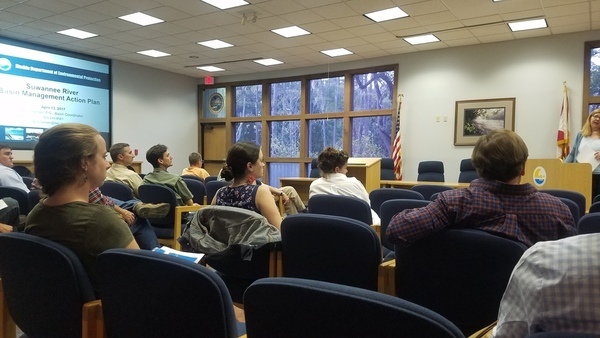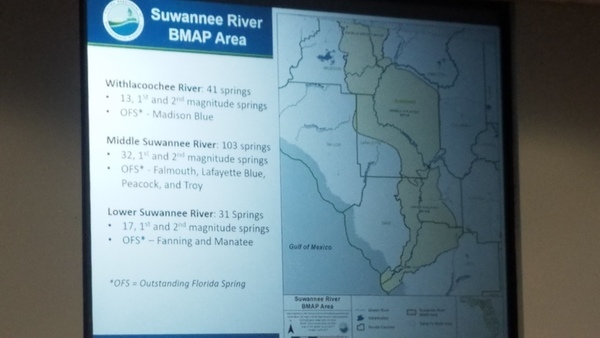The conclusion from FDEP in their BMAP presented to an almost-full SRWMD boardroom on April 13, 2017 was: nitrogen runoff into springs and rivers from all sources (the biggest being agriculture, dairies, and poultry) must decrease 83 to 93 percent. For once nobody seemed to argue with research by state agencies. Rather everyone, from representatives of the biggest of farmers to Pilgrim’s Pride to a wide variety of environmental groups seemed aghast at the severity of the situation.
This Basin Management Action Plan (BMAP) for the Lower and Middle Suwannee River Basin turns out to include the Withlacoochee River almost to the Georgia line, because the focus is on protecting springsheds, and Madison Blue Spring is a first magnitude spring. Water withdrawals factor into that research, which is more about where does that water go and what is carried with it. Answer: mostly nitrates from fertilizer, causing algae blooms and other ill effects.
Some of the possible paths going further were spelled out yesterday by Bob Palmer in the Gainesville Sun, 13 April 2017, Can agriculture and healthy springs coexist?,
I see three very different ways in which this impasse could play out as DEP moves from analysis into an actual action plan for the basin.
First, the state could help Suwannee Basin farmers adopt practices that release far less nitrogen to the groundwater. Best management practices could be implemented and enforced. In areas where nutrients are easily leached into the groundwater, which unfortunately is most of the BMAP area, the state could underwrite a shift toward crops (e.g. pine trees) that are not dependent upon heavy inputs of fertilizer. This is clearly the preferred option, one that has been advocated over the past year by the Florida Springs Council and the Sierra Club in their discussions with the state.
Alternatively, one can imagine a second path where the state kicks the can down the road. Targets would be set for the required five-year, 10-year and 15-year clean-up milestones mandated by Florida law. Then after five years, the milestones would conveniently not be met, and new milestones would be set. This process could go on indefinitely, with no measurable progress.
The third path is the easiest to imagine — the Florida Legislature would simply change the law to remove the requirements for cleaning up our springs. The 2016 springs protection legislation? Never mind, we didn’t really mean it.
I think Bob misses a stitch in his first alternative. It is possible to grow corn with a third as much fertlizer per acre as is commonly used. I say this because we do it on my place. And we don’t use any pesticides. Sure, we also don’t produce as many bushels per acre. But our corn sells for more because it’s a better product: cleaner and tastier, which matches many studies that show that such farming is more profitable for the farmer. This does not require any fancy new technology, either: it’s just winter cover crops, turning before planting, cultivating, and then hoeing the remaining weeds, with terraces to prevent runoff. Oh, and using real corn, not corn engineered for pesticide resistance over taste.
We probably actually get more than 66% reduction in nitrate runoff because of the terracing and contour plowing. In any case 66% to 83% is not nearly as big a step as all the way to 83%.
Bob is probably right that the state of Florida wouuld need to help farmers make this paradigm shift. So the legislature needs to put their money where their mouth was when they passed the law requiring these BMAPs.
And there is someone else with deep pockets who owns a lot of land in the Suwannee River Basin and who announced back in 2012, just as he started buying land in the Suwannee River Basin and numerous other places, that he wants to improve agriculture: Bill Gates.
It’s true his announcement seemed to be concentrating on seeds, which are not the main issue here: fertlizer is. And it’s true that announcement was made through a different organization, and it is his investment arm that has been buying up farmland. But even at Microsoft he demonstrated he could learn from experience, such as when in 1995 he finally decided to make his software work with the Internet.
Bill Gates already has some farms with signs saying Organic, that he’s fertilizing them with chicken manure. That seems like a good opportunity for experimenting with reaching the goals of the BMAP. Shouldn’t be that hard: the law allows 15-20 years to fix this problem.
So Mr. Gates, and that other west coast agriculture investor, Grimmway, could lead the way on this paradigm shift in agriculture in the Suwannee River Basin.
Many materials related to the Suwannee BMAPs are on the FDEP website. Materials from that April 13, 2017 meeting include the presentation slides in PDF and Word.
-jsq, John S. Quarterman, Suwannee RIVERKEEPER®
You can join this fun and work by becoming a WWALS member today!
Short Link:




Pingback: Suwannee BOCC approves Duke solar plant 2017-04-18 | WWALS Watershed Coalition (Suwannee RIVERKEEPER®)